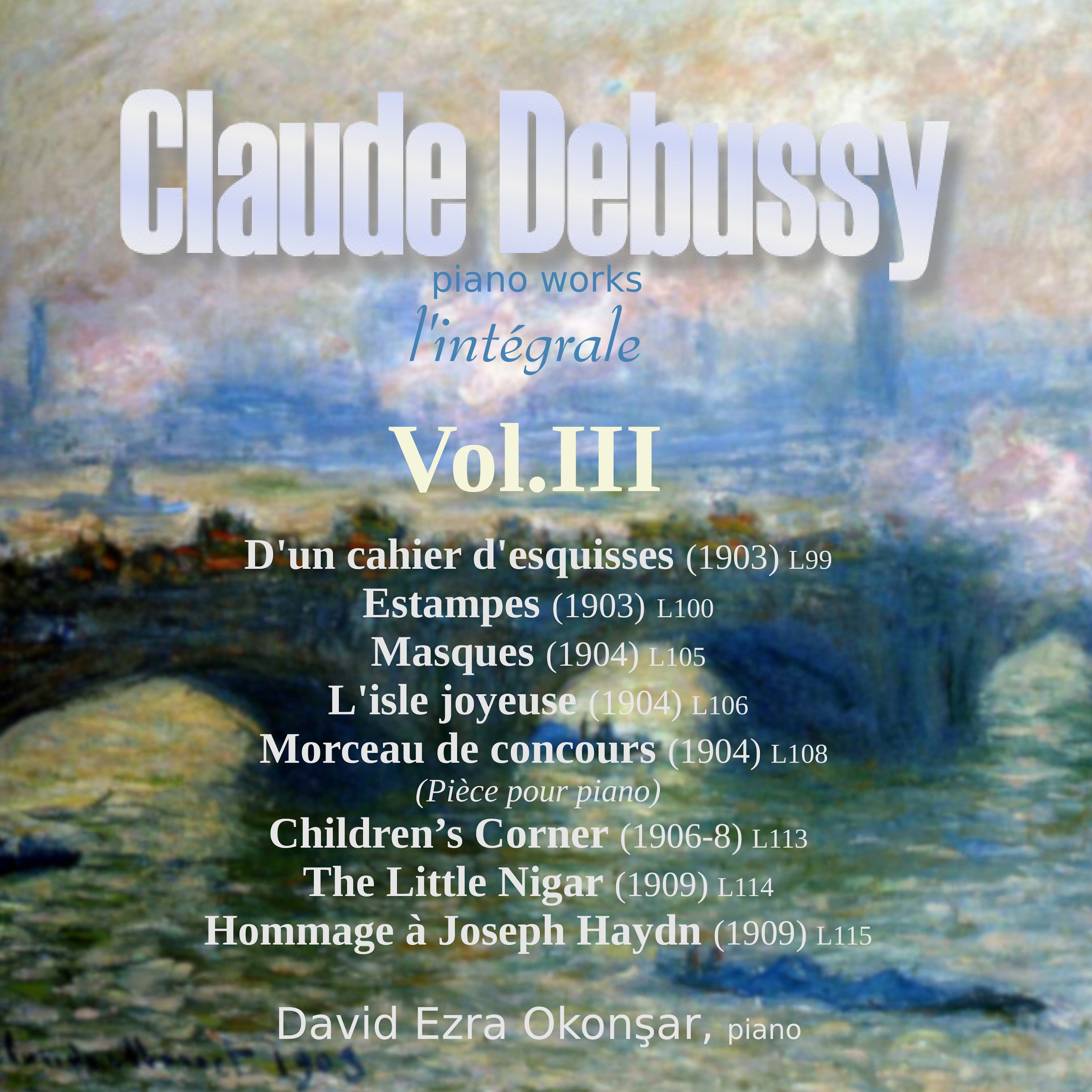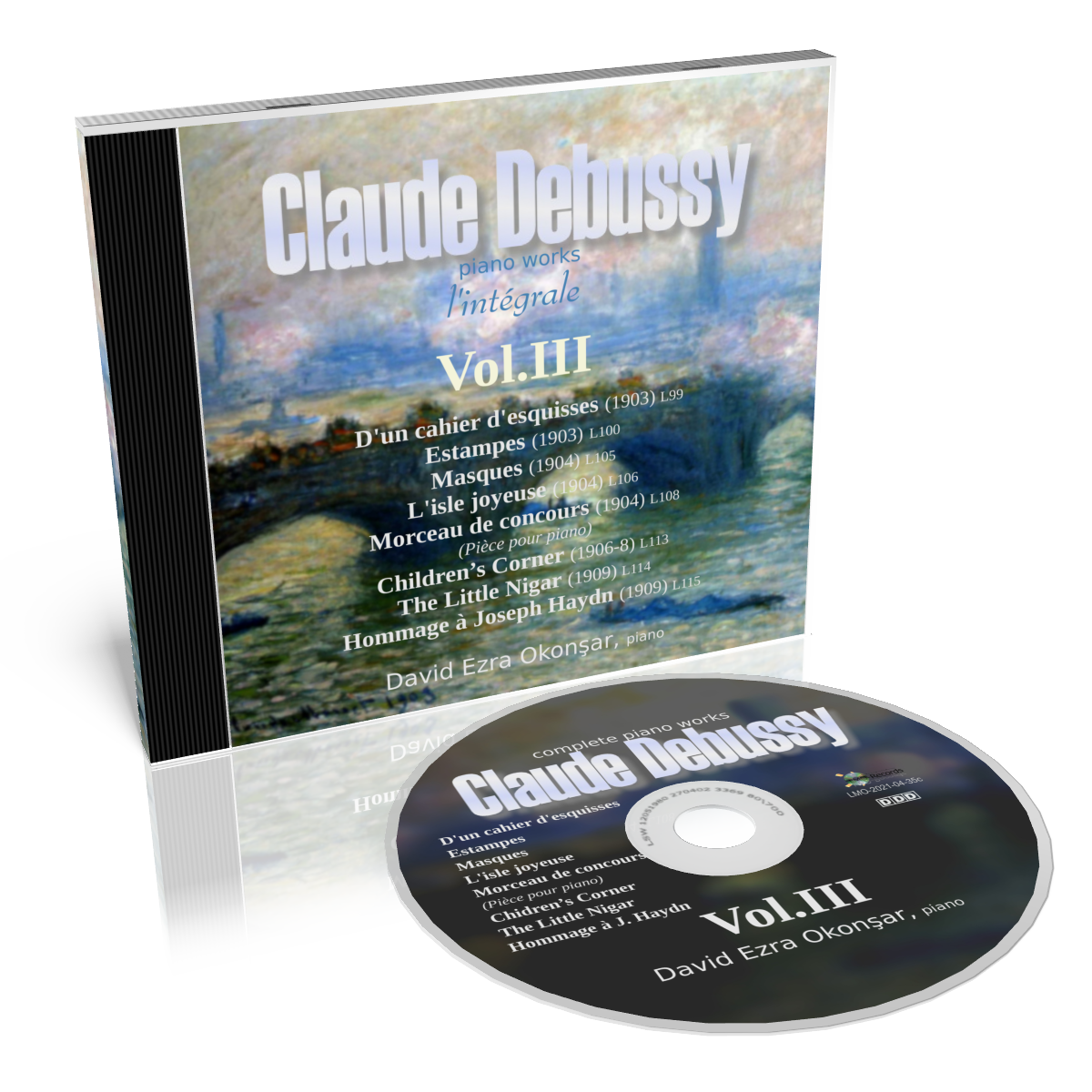

|
D'un cahier d'esquisses One of the most underrated pieces of the French composer is D'un cahier d'esquisses, L 99, (~1903). Its composition date is not known precisely. First published in 1904 as "Esquisse" in an album titled "Paris illustré" and later the same year by Schott Freres in Brussels with its own title, the piece was premiered at the inaugural concert in the Salle Gaveau of the Societé de Musique Indépendante, established by Gabirel Fauré. The performer was none other than Maurice Ravel. The outstanding quality of the melodic and harmonic elaborations is a precursor of Images. Estampes Estampes L 100 (1903) is the first attempt to a genre of piano music which will evolve into "Images" first and then, in its apex, to the "Préludes". Mono-thematic pieces that will not describe a scene or visual imagery but will refer to them as "soundscapes". In that particular artistic orientation, Debussy will create a unique piano écriture and Estampes are the first emergence of it. The series is composed with a creative surge in the summer of 1903. Durand first published the series in October 1903 and Ricardo Vines premiered it in the Salle Erard, the composition was very well received, specially the "Jardins sous la pluie" has been bis-sed. As the first piano composition after Pelleas, Estampes is full featured Debussy at the piano where he will be very productive up to the Etudes in 1915. Estampes I: Pagodes The Exposition Universelle in Paris (1889) and specially the pavilion of Bali, with the sounds of the Gamelang, deeply marked Debussy who created here a precursor masterpiece using Oriental sources. That will be abundantly show later in the works of Olivier Messiaen. It is an obsessively pentatonic music in B major. While the key colors are definitely Balinean, the overall structure is strongly in the Western tonal style. The prodigally intuitive genius of the composer creates a very deep and complex osmose by using the "oriental way of structuring music": "sound entities" taken as indivisible elements (without breaking them into rhythmic - melodic and harmonic themes) and the Western way of creating tonal centers, used here mostly as low pedal-tones. Estampes II: La soirée dans Grenade In his pamphlet titled Le Tombeau de Debussy, for the Revue Musicale, Manuel de Falla wrote in 1920: "The evocative power distilled in a few pages, as it appears in the "La Soirée dans Grenade" is nothing less than a prodigy if one thinks that the composer is guided only by his intiutive genius". Debussy never traveled to Spain except once towards the end of his life. de Falla concludes: "Although nothing is originated from the Spanish folklore, the entire piece creates a very strong feeling of Spain". Estampes III: Jardins sous la pluie This toccata-like piece re-uses a popular song theme ("Nous n'irons plus au bois") which was first employed in Images inédites (1894). Yet here this theme is secondary while another popular song "Do, do, l'enfant do" makes for the main theme. Two children songs as base motives for a glistening scenery of gardens, flowers, birds under a heavy but warm rain. Together with L'isle joyeuse, Masques L 105, (1904) is one of the two most elaborated solo piano pieces which do not belong to any series. They are both composed in a row in July 1904, published and premiered the same year. But they gained uneven popularities: while the L'isle joyeuse, with its immediate appeal and glistening virtuosity acquired rapidly favor among pianists, the Masques who followed it very shortly remained one of the most sublime and lesser known masterpieces of the composer. Masques Masques, in A minor, is a kind of mirror of the l'Isle joyeuse in A major. Its title often suggested its affinities with the Commedia dell'arte, yet Debussy clearly affirmed to Marguerite Long: "this is not the Italian comedy but the expression of the tragedy of life". A more adequate similitude may be drawn with the Scherzos by Chopin. Their interplay of light and darkness, the inherent anxiety violenty torn with revolting impetus. l'Isle joyeuse L 106, l'Isle joyeuse (1904) is an evocation with a marvelous and delicate poetry, well deserved by a lavish piano écriture, and could have been inspired by l'Embarquement pour Cythère, a painting by the French artist Jean-Antoine Watteau (1684 – 1721). It is also known as Voyage to Cythera and Pilgrimage to the Isle of Cythera. The painting is now in the Louvre in Paris. Right after the dark evil spells of Masques, here is euphoria under a bright sun, in front of a radiant sea, the fiery thriving love and joy ... without "masks" (Masques). Children's Corner From 1903 to 1907, from Pagodes to Poissons d'or, Debussy composed twelve sumptuous pieces for the piano, pieces with a bold pianistic écriture and amazing harmonic elaborations constantly rising. Just before embarking towards other summits, like the Préludes he probably needed some rest, some private intermission. This "intermission" is Children's Corner L 113, (1906–1908). Those miniatures whose refined simplicity reminds Enfantines by Mussorgsky, whom Debussy admired profoundly, are actually not for children neither to play or even to appreciate with all their sublime details. |
|||||||||||||||||||||||
| |
|||||||||||||||||||||||
|
|||||||||||||||||||||||





